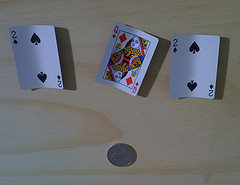As with many profound discoveries it began innocuously enough.
“I don’t believe that there are truly a billion Indians,” my friend Marcel has remarked more than once to me. Of course, when he first made this statement as a graduate student, maybe because it was after a late night party at Ms. Chan’s, I didn’t take him seriously. However, the events of the past few years, particularly each time I meet someone new, have convinced me that he’s probably on to something: There don’t seem to be a billion of us.
“Please meet my partner Habib, he’s coming down to the entrepreneur’s meet next week in Bangalore.”
Jaideep, a classmate who now was living in the U.S., and I had reconnected last Christmas at our 25th reunion. Despite, or more likely because of, the amount of libations consumed, he figured I must know a thing or two and asked me to share it with his Mumbai-based business partner.
Habib and I did connect over the phone soon after at a startup event and agreed to meet outside the auditorium just before lunch. When I made my way out of the hall a few minutes before midday, I found small clumps of people discussing the morning presentations and their own businesses. After several “Hail-fellow-well-met” intercepts, I heard my phone ring. It was Habib. As we exchanged “Where are you ats?” I spotted a bearded gentleman with a phone to his ear, standing next to my friend Dhruv just outside the gate.
“Habib?” I asked tentatively and the gentleman stuck out his hand
“You are Srikrishna?”
Inevitably, the discussion of “How do you know…” ensued between Dhruv (with whom Habib had worked for several years at an ad agency) and me. The longer we spoke, the more folks we found we knew in common.
Scientists in the U.S. as many as 50 years ago began exploring what they then termed “chains of acquaintances.” In fact, Stanley Milgram, then a young social psychologist (apparently you can study practically anything at Harvard) did his famous package-mailing experiment to see how short these chains of acquaintances were.
He mailed packages to 296 people asking them to post them on to a “final recipient.” None of them was told where the final recipient actually lived; just his name, occupation and some personal details (these were pre-Internet and pre-Google days, of course).
The folks who received the package were supposed get it delivered by passing it on to someone with whom they were on a first-name basis and who might have a better chance of finding the final recipient. Astonishingly, even without any Indians or Chinese being involved, the packages made it to their destinations in less than five hops.
Hollywood got in on the act with “Six Degrees of Separation,” based on the play of the same name by John Guare.
Before you know it, folks studying crickets and how diseases spread started working on this “Small World” theory. While the folks at the University of Virginia, in an urge to create something useful, released the Kevin Bacon game (look it up), Duncan Watts at Cornell published the first compendium of all key Small World theories.
What however was missing in all these studies is what my friend Dr. Sluiter, keen scientist that he is, formulated as Sluiter’s Lemma on Indian Connectedness or SLIC. I feel like Harrison Ford finding the Ark of the Covenant when I present these lemmas. If only these other folks had stumbled upon it sooner, the Small World theory would have made a whole lot more progress much earlier. But as the old saw goes: Better late than never.
Lemma 1: Any two Indians went to school with each other. Given the average Delhi Public School class has probably 300 kids in five sections, and every kid raised by a self-respecting, card-carrying Indian parent needs to become a doctor or an engineer, it’s almost inevitable that between 12 years of schooling and at least three years of college a good many of us have gone to school with one another. And this does not even count graduate school where a few more links can be forged. I can hear the mathematicians among you stating that the average IIT had only a class size of 400 to 600 and medical schools even less and that those are pretty small numbers. Fear not, Lemma 2 comes to the rescue.
Lemma 2: Or their siblings/friends went to school with each other. Regardless of what you may have read in this paper or other publications about the rise of nuclear families in urban India, we are blessed with a large number of siblings and cousins. When you now factor in all the other kids with whom we played on the street with marbles, tops, gilli-danda, cricket and numerous other sports, it quickly adds up.
Lemma 3: They are related to each other. In the unlikely event two Indians or their siblings or friends did not go to school together, they are usually related. “Oh, he’s my mother’s brother’s wife’s cousin’s son.” (In my case this person also happened to be my classmate in college.) In my brother-in-law’s case, he has found a good part of Tamil Nadu is related by blood — not that surprising when grandparents on either side have 12 siblings.
Lemma 4: If all of the above fail, they are married to each other. Drum roll on this one. Just when you felt that you’ve actually met a couple of Indians who are not connected, you’ll find, as Dr. Sluiter did, that they are married, either to each other or into each other’s families. Sometimes you can’t tell the difference in India, but that’s a story for another day.
This article first appeared in the India Real Time of the Wall Street Journal.












You must be logged in to post a comment.